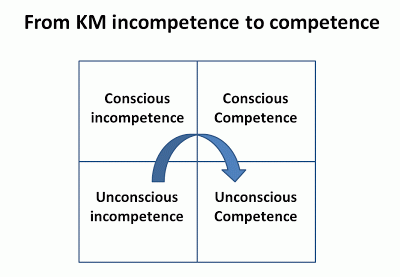Ten PowerPoint Slides on Knowledge Management that Have Influenced Me (Part 1)
Do you hate PowerPoint presentations? Well, you probably have
endured a lot of gruesome slides throughout the course of your professional life.
But despite the usual wisdom that PowerPoint slides for presentations should be
avoided whenever possible, I actually think that some well-crafted slides
presented in the right context can be a very good thing. In fact, there are a
number of slides that had a very positive impact on me in my knowledge
management career. I treasure them because they manage to bring complex
concepts to the point and often communicate an entire lesson’s worth of insight
just with one diagram, graph or image. Here’s a list of ten powerful slides on knowledge management
that have influenced me, which I am posting in two parts (for Part 2 click here). See for yourself whether you can get some inspiration from them.
© by Chris Collison and Geoff Parcell
This graphic is taken from Chris Collison’s and Geoff Parcell’s book “Learning to Fly”, considered by many to be the bible for KM practitioners. They use it to describe the process of how we learn, e.g. driving a car, which starts with the state of “ignorance is bliss”, over realizing that you want to drive a car but can’t, to consciously applying every step necessary to get a car moving, until you finally arrive at a state where you don’t even think anymore about how you drive – you just do it.
After I spent already one year in my very first KM job
trying to promote KM with senior management, it was this one slide during a
meeting with my superiors that suddenly made the managers understand where we
were with KM, and which resulted in the go-ahead for a real KM action plan backed
by management and the development of a strategy for the organization.
2. Organizations
yesterday and today
This slide was presented to me by a fellow participant of
the KM Institute’s “Certified Knowledge Manager” training in 2007. It captures
the essence of how organizations and therefore our work environments have
changed over the past decades: away from a modern, hierarchical, intransparent
and tightly controlled environment that sees infrastructure and money as its
main assets, towards a post-modern organization with flat hierarchies and open
and networked information flows that sees people and their knowledge as its
main assets. The point is of course not that all are organizations resemble the
right column today, but that 50 years ago, nobody questions the left column,
while today these characteristics would be seen as obstacles to productive
work. The table is inspired by the research of Philip Kotler, and is an excellent
teaser to discuss our role as knowledge workers.
3. The Cynefin framework
The Cynefin
framework (pronounced “key-nevin”) is a typology that describes in what contexts
and problem situations a certain sort of explanations and/or solutions may
apply, ranging from simple, to complicated, complex and chaotic problem
situations. The framework was originally developed in 1999 in the context of
knowledge management and organizational strategy by Dave Snowden, and provides
a powerful way of assessing what kind of KM initiative may be right within a specific
organizational context. It does e.g. away with the myth that “good practices”
are generally a good KM tool for organizations in any kind of situation, as according
to Cynefin they really only apply to a “complicated” setting.
4. Enterprise 2.0 Knowledge
Management – A Revolution of Knowledge in Three Parts
This entire slide set is surely one of the most fabulous PowerPoints I’ve ever seen (the screenshot just shows four exemplary slides). They are a perfect example of slides that work as a resource by themselves without anyone presenting, because they actually tell a story. The entire slide set consists of a presentation in three parts, which was developed and is being used as a marketing pitch by the German consultancy company Besser 2.0 for their Enterprise 2.0 services. In the presentation they demystify in a perfect way what Web 2.0 means and how it changes the game for knowledge management inside organizations. Whenever I need to explain to someone why corporate social networking important I refer to this slide show, and it has never failed to leave an impression and provide ground for a fruitful discussion.
5. Tacit and explicit
knowledge
This one is of course a classic, and should be part of any basic introduction to Knowledge Management. I like it because you can start with just asking the question and showing the iceberg picture, which will make the participants think and often discover themselves the key point behind this slide. I don’t know who came up with the iceberg analogy first, but evidently it is out there as common reference when you do a simple Google search. This particular iceberg image that I use in my presentations was taken from the blog ArtTech 101, although it is not clear with whom the copyright of the image resides.
To get to Part 2 of this blog post, click here.








Comments
Thanks for sharing your reference slides, they're really good. Particularly like the 1st one and the Cynefin one (which has also deeply influenced me).
Also wanted to say that there shouldn't be a "usual wisdom that PowerPoint slides for presentations should be avoided whenever possible". Powerpoints are just tools, how they are used make them great or terrible.
I'm not particularly a fan of making PPTs myself but I really don't like the 'war on PPTs' waged on PPT by even some KM friends of mine.
So thanks again for sharing those and I look forward to part 2!
I'm flattered. (I wish we'd invented the model!)
Enjoyed the other 9 too...